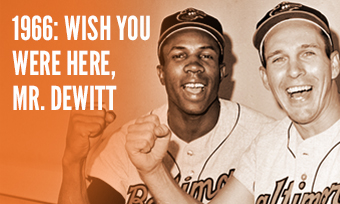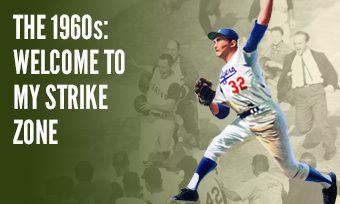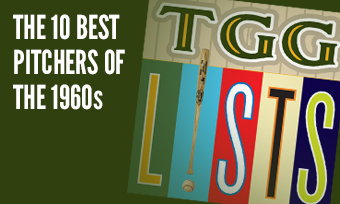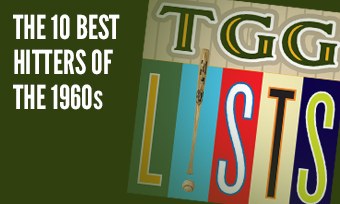The Yearly Reader
Leaders and Honors, 1966
Our list of baseball’s top 10 hitters and pitchers in both the American League and National League for the 1966 baseball season, as well as the awards and honors given to the game’s top achievers of the year.
The National League’s Top 10 Hitters, 1966
Bold type in brick red indicates league leader.
1. Richie Allen, Philadelphia
Key Numbers: .317 average, 112 runs, 165 hits, 25 doubles, 10 triples, 41 home runs, 110 RBIs, 10 stolen bases, .632 slugging percentage.
Despite a shoulder injury that would keep him out for nearly a month, Allen became the first Phillie to hit 40 homers since Chuck Klein.
2. Hank Aaron, Atlanta
Key Numbers: .279 average, 117 runs, 44 home runs, 127 RBIs, 76 walks, 21 stolen bases.
The Braves’ move to Atlanta Fulton-County Stadium—a.k.a., The Launching Pad—enriched Aaron’s power game, matching his uniform number for the third time with 44 homers.
3. Roberto Clemente, Pittsburgh
Key Numbers: .317 average, 105 runs, 202 hits, 31 doubles, 11 triples, 29 home runs, 119 RBIs.
Clemente caught the homer bug with a career-high 29, but failed to win a batting title for the only time in a four-year stretch; his overall numbers were still got enough to grab his lone MVP award.
4. Willie McCovey, San Francisco
Key Numbers: .295 average, 85 runs, 26 doubles, 6 triples, 36 home runs, 96 RBIs, 76 walks.
McCovey was part of a trio of Giants (along with Willie Mays and Jim Ray Hart) to each belt 30-plus homers, the third such accomplishment in four years at San Francisco.
5. Willie Mays, San Francisco
Key Numbers: .288 average, 99 runs, 29 doubles, 37 home runs, 103 RBIs, 70 walks.
Mays became, for the moment, the NL’s all-time home run king; at age 35, he’d never hit more than 30 in a season again.
6. Willie Stargell, Pittsburgh
Key Numbers: 140 games, .315 average, 84 runs, 30 doubles, 33 home runs, 102 RBIs.
Pops set a career mark in batting average, part of a Pittsburgh outfield that overall hit .318 (back-ups included).
7. Ron Santo, Chicago
Key Numbers: .312 average, 93 runs, 175 hits, 21 doubles, 8 triples, 30 home runs, 94 RBIs, 95 walks, .412 on-base percentage.
Santo’s outstanding year included a 28-game hitting streak, the Cubs’ longest until 1989.
8. Felipe Alou, Atlanta
Key Numbers: .327 average, 666 at-bats, 122 runs, 218 hits, 32 doubles, 6 triples, 31 home runs, 74 RBIs, 12 hit-by-pitches.
Alou wasn’t just second in the NL in hitting—he was second within his own family, as the Pirates’ Matty Alou put together a .342 figure. His 31 homers—17 hit while leading off—were easily the most accumulated in one season among he and his brothers, neither of whom ever reached double figures.
9. Joe Torre, Atlanta
Key Numbers: .315 average, 83 runs, 172 hits, 36 home runs, 101 RBIs.
Along with Aaron and Alou above, the Braves’ arrival at the Launching Pad also pumped up the home run totals for Torre, who set a career high.
10. Donn Clendenon, Pittsburgh
Key Numbers: .299 average, 80 runs, 171 hits, 22 doubles, 10 triples, 28 home runs, 98 RBIs, 142 strikeouts.
The gifted athlete who was once scouted by football’s Cleveland Browns and basketball’s Harlem Globetrotters had a career year, mostly on the road—25 of his 28 home runs came away from Forbes Field. It was surely enough to impress his ‘big brother’ back at Morehouse College: Martin Luther King Jr.
The American League’s Top 10 Hitters, 1966
1. Frank Robinson, Baltimore
Key Numbers: .316 average, 122 runs, 182 hits, 34 doubles, 49 home runs, 122 RBIs, 87 walks, .410 on-base percentage, .637 slugging percentage, 24 grounded into double plays.
One frustration in an otherwise flawless campaign: Robinson went homerless in his final eight games to miss out on reaching 50.
2. Harmon Killebrew, Minnesota
Key Numbers: .281 average, 89 runs, 27 doubles, 39 home runs, 110 RBIs, 103 walks, 18 intentional walks.
Never, ever to be confused as a batting champ, Killebrew (career batting average: .256) stunningly placed fifth in the AL batting race with a .281 mark—the second highest of his 22-year major league lifespan.
3. Al Kaline, Detroit
Key Numbers: 142 games, .288 average, 85 runs, 29 doubles, 29 home runs, 88 RBIs, 81 walks.
After Frank Robinson and Tony Oliva, you had to reach down to Kaline to find the AL’s third highest batting average—at .288.
4. Tony Oliva, Minnesota
Key Numbers: .307 average, 99 runs, 191 hits, 32 doubles, 7 triples, 25 home runs, 87 RBIs, 13 stolen bases.
Oliva didn’t capture his third batting title in as many years—only Frank Robinson got in the way—but he did pace the AL in hits for a third straight time.
5. Boog Powell, Baltimore
Key Numbers: 140 games, .287 average, 34 home runs, 109 RBIs.
In a strong comeback performance, Powell notched the most RBIs in a single 1966 game by a position player. (Pitcher Tony Cloninger knocked in nine in his double-grand slam effort to lead all players.)
6. Norm Cash, Detroit
Key Numbers: .279 average, 98 runs, 168 hits, 32 home runs, 93 RBIs.
In the long and empty search to duplicate his sensational 1961 numbers, Cash had about as fine a complete season since.
7. Tommie Agee, Chicago
Key Numbers: .273 average, 98 runs, 172 hits, 27 doubles, 8 triples, 22 home runs, 86 RBIs, 10 hit-by-pitches, 44 stolen bases.
After a series of hand injuries suppressed his progress to the majors, a healthy Agee finally busted out as an all-around threat and AL Rookie of the Year.
8. Dick McAuliffe, Detroit
Key Numbers: 124 games, .274 average, 83 runs, 16 doubles, 8 triples, 23 home runs, 56 RBIs.
The typically light-hitting (.247 career average) shortstop hit a personal-best .274.
9. Tony Conigliaro, Boston
Key Numbers: .265 average, 26 doubles, 7 triples, 28 home runs, 93 RBIs.
The 21-year old’s team-leading 28 homers gave him 82 through his first three years—just two behind Mel Ott’s record for the most by a player before turning 22.
10. Willie Horton, Detroit
Key Numbers: .262 average, 22 doubles, 6 triples, 27 home runs, 100 RBIs.
For the second time in two everyday seasons, Horton knocked in 100 runs; he wouldn’t do it again until 1979 for the Seattle Mariners.
The National League’s Top 10 Pitchers, 1966
1. Sandy Koufax, Los Angeles
Key Numbers: 1.73 ERA, 27 wins, 9 losses, .750 win percentage, 41 starts, 27 complete games, 323 innings, 77 walks, 317 strikeouts.
Koufax went out on top, but ever so painfully.
2. Juan Marichal, San Francisco
Key Numbers: 2.23 ERA, 25 wins, 6 losses, .806 win percentage, 36 starts, 307.1 innings, 36 walks.
Once again, Marichal had to settle for second fiddle in Koufax’s wake; his 14-inning shutout of the Phillies on May 26 was the second longest of his career, behind his famous 16-inning blanking of the Braves and Warren Spahn in 1963.
3. Bob Gibson, St. Louis
Key Numbers: 2.44 ERA, 21 wins, 12 losses, 35 starts, 280.1 innings, 12 wild pitches.
The Cardinals scored only 16 runs in the 12 losses Gibson suffered.
4. Gaylord Perry, San Francisco
Key Numbers: 2.99 ERA, 21 wins, 8 losses, .724 win percentage, 35 starts, 255.2 innings, 40 walks.
After throwing wildly the year before, Perry cut down on the walks—but perhaps not the Vaseline—in winning over 20 for the first time.
5. Claude Osteen, Los Angeles
Key Numbers: 2.85 ERA, 17 wins, 14 losses, 38 starts, 240.1 innings, 65 walks, 13 intentional walks.
In his second year with the Dodgers, Osteen gave up just six home runs.
6. Mike Cuellar, Houston
Key Numbers: 2.22 ERA, 12 wins, 10 losses, 38 appearances, 28 starts, 227.1 innings, 52 walks.
Beginning his fourth season as, once again, a reliever, Cuellar was given the chance to start at the end of April and fired two complete-game wins, allowing a total of one earned run; that convinced the Astros that his days in the bullpen were done.
7. Jim Bunning, Philadelphia
Key Numbers: 2.41 ERA, 19 wins, 14 losses, 41 starts, 314 innings, 55 walks, 252 strikeouts, 19 hit-by-pitches, 22 stolen bases allowed.
Bunning failed to win either of his last two starts, finishing with 19 triumphs for the third straight year.
8. Phil Regan, Los Angeles
Key Numbers: 1.62 ERA, 14 wins, 1 loss, .933 win percentage, 21 saves, 65 appearances, 0 starts, 116.2 innings, 24 walks.
In no other year did Regan more appropriately deserve his nickname of “The Vulture,” as few who came within his path at the plate were spared.
9. Bob Veale, Pittsburgh
Key Numbers: 3.02 ERA, 16 wins, 12 losses, 37 starts, 268.1 innings, 102 walks, 27 grounded into double plays.
The 30-year-old southpaw remained the rock of the Pittsburgh rotation with his third straight (16 or more)-12 record.
10. Al Jackson, St. Louis
Key Numbers: 2.51 ERA, 13 wins, 15 losses, 36 appearances, 30 starts, 232.2 innings, 45 walks.
After four years and a 40-73 record with the terrible Mets, a 13-15 ledger with the Cardinals probably felt like nirvana for Jackson—even if he deserved better with a 2.51 ERA.
The American League’s Top 10 Pitchers, 1966
1. Jim Kaat, Minnesota
Key Numbers: 2.75 ERA, 25 wins, 13 losses, 41 starts, 19 complete games, 304.2 innings, 55 walks, 24 grounded into double plays.
For Kaat, who succeeded with Warren Spahn’s recipe for 20 victories—winning at least four games a month—it was as easy done as said.
2. Gary Peters, Chicago
Key Numbers: 1.98 ERA, 12 wins, 10 losses, 30 appearances, 27 starts, 204.2 innings, 45 walks.
Peters’ 12 wins were the fewest by an AL ERA leader with a sub-2.00 mark since Ed Siever went 8-11 on 1.91 for Detroit in 1902.
3. Tommy John, Chicago
Key Numbers: 2.62 ERA, 14 wins, 11 losses, 33 starts, 5 shutouts, 223 innings, 22 grounded into double plays.
John helped ease the pain of White Sox fans who still missed Rocky Colavito—the man John was traded for.
4. Sonny Siebert, Cleveland
Key Numbers: 2.80 ERA, 16 wins, 8 losses, .667 win percentage, 32 starts, 241 innings, 12 caught stealing/picked off.
Siebert’s second straight 16-8 season included the majors’ only no-hitter of the year—and the only one of his career.
5. Steve Hargan, Cleveland
Key Numbers: 2.48 ERA, 13 wins, 10 losses, 38 appearances, 21 starts, 192 innings, 45 walks.
Among Hargan’s first 16 appearances—all in relief—was a 10-inning gem out of the bullpen in which he allowed just one run, picked up the win and convinced the coaching the staff that he could adapt well to a spot in the rotation. Which, in the season’s second half, he did.
6. Jack Aker, Kansas City
Key Numbers: 1.99 ERA, 8 wins, 4 losses, 32 saves, 66 appearances, 0 starts, 113 innings, 28 walks.
Aker became the latest reliever to raise the bar on record saves for a season, breaking Ted Abernathy’s mark from just the year before.
7. Earl Wilson, Boston-Detroit
Key Numbers: 3.07 ERA, 18 wins, 11 losses, 37 starts, 264 innings, 27 grounded into double plays.
An early-season trade to the Tigers—an ill-fated one from the Red Sox’ perspective—not only led to Wilson being one of Detroit’s better pitchers, but one of its better hitters; in 64 at-bats, he hit five home runs with 17 RBIs.
8. Jim Perry, Minnesota
Key Numbers: 2.54 ERA, 11 wins, 7 losses, 33 appearances, 25 starts, 184.1 innings.
No longer the better known of the Perry brothers with the emergence of Gaylord in San Francisco, Jim continued a slow renaissance back to form after a wobbly 1961-64.
9. Sam McDowell, Cleveland
Key Numbers: 2.87 ERA, 9 wins, 8 losses, 3 saves, 35 appearances, 28 starts, 5 shutouts, 194.1 innings, 102 walks, 225 strikeouts.
Arm issues limited McDowell’s rotation duty in late spring, part of why he won just nine games—but five of those were by shutout, with two of those back-to-back one-hitters early in the season.
10. Denny McLain, Detroit
Key Numbers: 3.92 ERA, 20 wins, 14 losses, 38 starts, 264.1 innings, 104 walks.
Proof that no one gave a damn about pitch counts back in the 1960s: One of McLain’s 20 victories was a 6-3 win at Baltimore in which he struck out 11, walked nine and threw 229 pitches.









